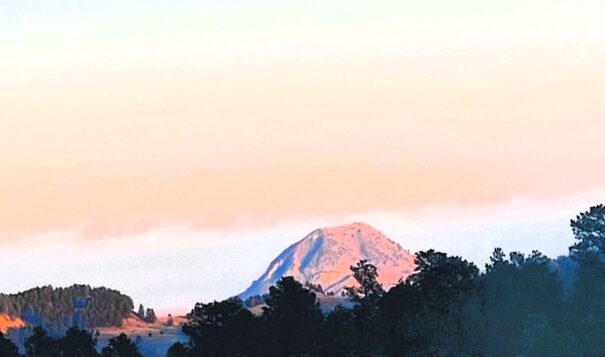News Based on facts, either observed and verified directly by the reporter, or reported and verified from knowledgeable sources.
Cheyenne River Youth Project purchases land near Bear Butte
 Bear Butte is one place in the Black Hills where “many of our important ceremonies happen.” Photo credit/ Talli Nauman
Bear Butte is one place in the Black Hills where “many of our important ceremonies happen.” Photo credit/ Talli Nauman
Native-led project buys 40 acres of land near site in South Dakota sacred to Lakota
A 35-year-old, Native-led nonprofit organization is taking steps toward reuniting youth with sacred sites.
On April 11, the Cheyenne River Youth Project announced that it had purchased 40 acres of land adjacent to Bear Butte State Park in Meade County, South Dakota.
The nonprofit will hold a private dedication ceremony with youth from the Cheyenne River Reservation on Friday, April 26.
This purchase brings the Cheyenne River Youth Project into the larger Land Back movement, a generations-long effort to reunite Indigenous people with their ancestral lands.
Mato Paha, or Bear Butte, is one of the most sacred sites for the Lakota people. Access to Bear Butte was severed in the 19th Century with the seizure of the Black Hills and dissolution of the Great Sioux Reservation into the modern-day Cheyenne River, Rosebud, Pine Ridge, Lower Brule, Crow Creek and Standing Rock reservations.
“In 1980, the U.S. Supreme Court ruled that the United States had illegally taken the Black Hills,” said Julie Garreau, Cheyenne River Youth Project’s chief executive officer, in an April 11 press release. “U.S. Supreme Court Justice Harry Blackmun wrote, ‘A more ripe and rank case of dishonest dealings may never be found in our history.’”
Garreau said many tribal citizens have to make a five-hour round trip to visit Bear Butte and often can’t afford lodging prices. Garreau and her team thought it was important to make the purchase now as land values continue to skyrocket.
“Now, with this land, we have a foundation,” Garreau said. “We will be able (to) bring our children here for culture camps, internship activities, workshops and physical activities, and we can take them on field trips to other important sites like Wind Cave, Black Elk Peak and Mato Tipila (Devil’s Tower).”
The 40-acre tract comes with organic certification from the U.S. Department of Agriculture, which Garreau said the Cheyenne River Youth Project will maintain in perpetuity.
“After 35 years of doing our work on the Cheyenne River Reservation, we know that strengthening connections to culture, ancestors and sacred places are vital to healing historical trauma,” Garreau said. “This land is a place for our youth to feel the power and depth of those connections as they become caretakers themselves — and, ultimately, find healing.”
To learn more about the Cheyenne River Youth Project and for information about making donations and volunteering, call (605) 964-8200 or visit www.lakotayouth.org.
